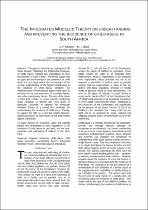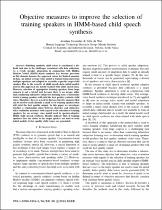 ResearchSpace
ResearchSpace
Modeling the differential incidence of "child abuse, neglect and exploitation" in poor households in South Africa: Focus on child trafficking
JavaScript is disabled for your browser. Some features of this site may not work without it.
- ResearchSpace
- →
- Research Publications/Outputs
- →
- Journal Articles
- →
- View Item
| dc.contributor.author |
Mbecke, P

|
|
| dc.date.accessioned | 2012-06-21T10:29:03Z | |
| dc.date.available | 2012-06-21T10:29:03Z | |
| dc.date.issued | 2010-06 | |
| dc.identifier.citation | Mbecke, P. 2010. Modeling the differential incidence of "child abuse, neglect and exploitation" in poor households in South Africa: Focus on child trafficking. African Journal of Criminology & Justice Studies, vol. 4(1), pp 87-115 | en_US |
| dc.identifier.issn | 1554-3897 | |
| dc.identifier.uri | http://wwwcf.umes.edu/WorkArea/showcontent.aspx?id=28792 | |
| dc.identifier.uri | http://hdl.handle.net/10204/5929 | |
| dc.description | Copyright: 2010 The author. This paper is published in the African Journal of Criminology & Justice Studies, vol. 4(1), pp 87-115 | en_US |
| dc.description.abstract | This paper is based on an in-progress Ph.D. research themed: “Modeling the Differential Incidence of Child Abuse, Neglect and Exploitation in Poor Households in South Africa”. The aim of the research is to build a theoretical grounding and to propose a practical model for understanding child abuse. The research argues that the gaps and shortcomings in understanding child abuse are, to a large extent, the consequence of an over-estimation of socio-economic variables as main variables contributing to the incidence of child abuse. The paper does not attempt to collect data on child trafficking to explain its extent in South Africa but aims to suggest the use of the Integrated Modeled Theory (IMT) to facilitate the understanding of the incidence of child abuse in general and child trafficking in particular. The IMT combines contributing variables from various theories to explain the incidence of child abuse (including child trafficking) and suggests mechanisms for prevention of and interventions against child abuse (child trafficking). The IMT is therefore a tool that assists in the decision-making process for prevention and intervention actions against child trafficking during and after the 2010 Fifa World Cup tournament seen as a great opportunity for child traffickers. | en_US |
| dc.language.iso | en | en_US |
| dc.publisher | African Criminology and Justice Association | en_US |
| dc.relation.ispartofseries | Workflow;9153 | |
| dc.subject | Child abuse | en_US |
| dc.subject | Child exploitation | en_US |
| dc.subject | Child neglect | en_US |
| dc.subject | South African poor households | en_US |
| dc.subject | Integrated Modeled Theory | en_US |
| dc.subject | IMT | en_US |
| dc.subject | Child trafficking | en_US |
| dc.subject | Criminology | en_US |
| dc.title | Modeling the differential incidence of "child abuse, neglect and exploitation" in poor households in South Africa: Focus on child trafficking | en_US |
| dc.type | Article | en_US |
| dc.identifier.apacitation | Mbecke, P. (2010). Modeling the differential incidence of "child abuse, neglect and exploitation" in poor households in South Africa: Focus on child trafficking. http://hdl.handle.net/10204/5929 | en_ZA |
| dc.identifier.chicagocitation | Mbecke, P "Modeling the differential incidence of "child abuse, neglect and exploitation" in poor households in South Africa: Focus on child trafficking." (2010) http://hdl.handle.net/10204/5929 | en_ZA |
| dc.identifier.vancouvercitation | Mbecke P. Modeling the differential incidence of "child abuse, neglect and exploitation" in poor households in South Africa: Focus on child trafficking. 2010; http://hdl.handle.net/10204/5929. | en_ZA |
| dc.identifier.ris | TY - Article AU - Mbecke, P AB - This paper is based on an in-progress Ph.D. research themed: “Modeling the Differential Incidence of Child Abuse, Neglect and Exploitation in Poor Households in South Africa”. The aim of the research is to build a theoretical grounding and to propose a practical model for understanding child abuse. The research argues that the gaps and shortcomings in understanding child abuse are, to a large extent, the consequence of an over-estimation of socio-economic variables as main variables contributing to the incidence of child abuse. The paper does not attempt to collect data on child trafficking to explain its extent in South Africa but aims to suggest the use of the Integrated Modeled Theory (IMT) to facilitate the understanding of the incidence of child abuse in general and child trafficking in particular. The IMT combines contributing variables from various theories to explain the incidence of child abuse (including child trafficking) and suggests mechanisms for prevention of and interventions against child abuse (child trafficking). The IMT is therefore a tool that assists in the decision-making process for prevention and intervention actions against child trafficking during and after the 2010 Fifa World Cup tournament seen as a great opportunity for child traffickers. DA - 2010-06 DB - ResearchSpace DP - CSIR KW - Child abuse KW - Child exploitation KW - Child neglect KW - South African poor households KW - Integrated Modeled Theory KW - IMT KW - Child trafficking KW - Criminology LK - https://researchspace.csir.co.za PY - 2010 SM - 1554-3897 T1 - Modeling the differential incidence of "child abuse, neglect and exploitation" in poor households in South Africa: Focus on child trafficking TI - Modeling the differential incidence of "child abuse, neglect and exploitation" in poor households in South Africa: Focus on child trafficking UR - http://hdl.handle.net/10204/5929 ER - | en_ZA |








